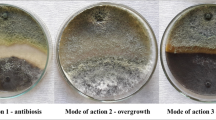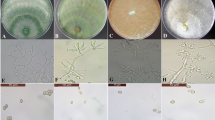Abstract
Charcoal rot incited by Macrophomina phaseolina is one of the major diseases of green gram and black gram in Pakistan reducing yields up to 40%. As there are no long-term control strategies for this seed- and soil-borne pathogen, therefore, in the present study, seven indigenous species of Trichoderma were evaluated for their in vitro and in vivo effectiveness against M. phaseolina with the objective to identify alternatives to pernicious fungicides. All seven species of Trichoderma significantly retarded the growth of M. phaseolina in vitro. Maximum reduction (79.63%) was observed with T. harzianum followed by T. hamatum (76.3%) while T. pseudokoningii caused the minimum decrease (58.14%) in growth of the fungus. Similarly, Trichoderma species had significant effects on number and size of sclerotia. M. phaseolina produced the minimum number of sclerotia in the presence of T. hamatum followed by T. harzianum causing reductions of 69.5 and 66.84% over control, respectively. The maximum reduction in size of sclerotia was caused by T. harzianum. The maximum plant survival of green and black gram was obtained with T. harzianum followed by T. hamatum and T. viride. The maximum individual germination of 86.67% was achieved with T. harzianum at a concentration of 2 × 108 (propagules/ml), while the minimum (33.33%) was recorded with T. pseudokoningii at 2 × 104. Trichoderma concentrations also had significant effects on plant survival, being the maximum at the highest concentration. The plant survival decreased as the concentrations of the antagonists decreased showing a direct relationship between plant survival and concentrations.
Zusammenfassung
Die durch Macrophomina phaseolina hervorgerufene Holzkohlenfäule ist eine der Hauptkrankheiten bei der Mungbohne und der Urdbohne in Pakistan und reduziert die Erträge um bis zu 40 %. Da es keine langfristigen Bekämpfungsstrategien für diesen samen- und bodenbürtigen Erreger gibt, wurden in der vorliegenden Studie sieben einheimische Trichoderma-Arten auf ihre in-vitro- und in-vivo-Wirksamkeit gegen M. phaseolina mit dem Ziel untersucht, Alternativen zu schädlichen Fungiziden zu finden. Alle sieben Trichoderma-Arten verzögerten das Wachstum von M. phaseolina in vitro signifikant. Die maximale Reduktion (79,63 %) wurde bei T. harzianum beobachtet, gefolgt von T. hamatum (76,3 %), während T. pseudokoningii die geringste Abnahme (58,14 %) des Pilzwachstums verursachte. In ähnlicher Weise hatten die Trichoderma-Arten signifikante Auswirkungen auf Anzahl und Größe der Sklerotien. M. phaseolina produzierte die minimale Anzahl von Sklerotien in Anwesenheit von T. hamatum, gefolgt von T. harzianum, was zu einer Verringerung um 69,5 % bzw. 66,84 % gegenüber der Kontrolle führte. Die maximale Verringerung der Größe der Sklerotien wurde durch T. harzianum verursacht. Das maximale Überleben der Mungbohne und der Urdbohne wurde mit T. harzianum erreicht, gefolgt von T. hamatum und T. viride. Die maximale Keimung von 86,67 % wurde mit T. harzianum bei einer Konzentration von 2 × 108 (propagules/ml) erreicht, während das Minimum (33,33 %) mit T. pseudokoningii bei 2 × 104 erfasst wurde. Die verwendeten Trichoderma-Konzentrationen hatten ebenfalls signifikante Auswirkungen auf das Überleben der Pflanzen, wobei das Maximum bei der höchsten Konzentration erreicht wurde. Das Pflanzenüberleben nahm mit der Reduktion der Konzentrationen ab, was eine direkte Beziehung zwischen dem Pflanzenüberleben und den Konzentrationen zeigte.



Similar content being viewed by others
References
Adekunle AT, Cardwell KF, Florini DA, Ikotun T (2001) Seed treatment with Trichoderma species for control of damping-off of cowpea caused by Macrophomina phaseolina. Biocontrol Sci Technol 11:449–457
Alice D, Ebenezar EG, Siraprakasan K (1996) Biocontrol of Macrophomina phaseolina causing root rot of jasmine. J Ecobiol 8:17–20
Anonymous (2018) Agricultural Statistics of Pakistan, Ministry of Food, Agriculture and Live Stock, Agriculture and Livestock Division, Islamabad, Pakistan
Ashraf M, Badri ZA, Eswaran A (2006) Bioefficacy of fungal antagonists against Macrophomina phaseolina (Tassi) Goid. Causing root rot of mungbean. Environ Ecol 24:1016–1018
Aslam MA, Javed K, Javed H, Mukhtar T, Bashir MS (2019a) Infestation of Helicoverpa armigera Hübner (Noctuidae: Lepidoptera) on soybean cultivars in Pothwar region and relationship with physico-morphic characters. Pak J Agri Sci 56(2):401–405
Aslam MN, Mukhtar T, Jamil M, Nafees M (2019b) Analysis of aubergine germplasm for resistance sources to bacterial wilt incited by Ralstonia solanacearum. Pak J Agri Sci 56:119–122
Barnett HL, Hunter BB (1972) Illustrated genera of imperfect fungi. Burgress, Minneapolis
Bashir MA, Malik BA (1988) Diseases of major pulse crops in Pakistan. Trop Pest Manag 34:309–314
Chao WL, Nelson EB, Harmen GE, Hoch HC (1986) Colonization of the rhizosphere by biological control agents applied to seeds. Phytopathology 76:60–65
Charles YY (1978) Mungbean diseases and control. The first international mungbean symposium AVRDC, Tiawan, p 262
Chet I (1987) Trichoderma-Application, mode of action and potential as a biocontrol agent of soil-borne pathogenic fungi. In: Chet I (ed) Innovative approaches to plant disease control. John Wiley & Sons Inc., Hoboken, pp 137–160
Compant S, Duffy B, Nowak J, Clement C, Barka EA (2005) Use of plant growth promoting bacteria for biocontrol of plant diseases. Principles, mechanism of action and future prospects. Appl Environ Microbiol 71:4951–4959
Dawar S, Hayat S, Anis M, Zaki MJ (2008) Effect of seed coating material in the efficacy of microbial antagonists for the control of root rot fungi on okra and sunflower. Pak J Bot 40:1269–1278
Etebarian HR (2006) Evaluation of Trichoderma Isolates for biological control of charcoal stem rot in melon caused by Macrophomina phaseolina. J Agric Sci Technol 8:243–250
Ghazanfar MU, Raza M, Raza W, Qamar MI (2018) Trichoderma as potential biocontrol agent, its exploitation in agriculture: a review. Plant Prot 2:23–41
Gupta R, Sexena RK, Chaturvedi P, Viride JS (1995) Chitinase production by Streptomyces viridificans: Its potential in fungal cell wall lysis. J Appl Bacteriol 78:378–383
Hashem M (2004) Biological control of two phytopathogenic fungal species isolated from the rhizoplane of soybean (Glycine max). Czech Mycol 56:223–238
Hendelsman J, Eric VS (1996) Biocontrol of soil borne plant pathogens. Plant Cell 8:1855–1869
Hoes JA (1985) Macrophomina phaseolina causal agent of charcoal rot of sunflower and other crops. Agric Res Stn, Morden Manitoba, Canada
Howell CR (2003) Mechanisms employed by Trichoderma species in the biological control of plant diseases: The history and evolution of current concepts. Plant Dis 87:4–10
Hussain MA, Mukhtar T (2019) Root-knot nematodes infecting okra in major vegetable growing districts of Punjab, Pakistan. Pak J Zool 51(3):1137–1143
Hussain S, Ghaffar A, Aslam M (1990) Biological control of Macrophomina phaseolina charcoal rot of sunflower and mungbean. J Phytopathol 130:157–160
Iqbal U, Mukhtar T (2014) Morphological and pathogenic variability among Macrophomina phaseolina isolates associated with mungbean (Vigna radiata L.) Wilczek from Pakistan. Sci World J. https://doi.org/10.1155/2014/950175. Article ID 950175
Iqbal U, Mukhtar T (2020) Inhibitory effects of some fungicides against Macrophomina phaseolina causing charcoal rot. Pak J Zool 52(2):709–715
Iqbal U, Mukhtar T, Iqbal SM (2014) In vitro and in vivo evaluation of antifungal activities of some antagonistic plants against charcoal rot causing fungus, Macrophomina phaseolina. Pak J Agri Sci 51:691–696
Javaid A, Afzal L, Shoaib A (2017) Biological control of charcoal rot of mungbean by Trichoderma harzianum and shoot dry biomass of Sisymbrium irio. Plant Daninha 35:e17165756
Javed K, Javed H, Mukhtar T, Qiu D (2019a) Efficacy of Beauveria bassiana and Verticillium lecanii for the management of whitefly and aphid. Pak J Agri Sci 56(3):669–674
Javed K, Javed H, Mukhtar T, Qiu D (2019b) Pathogenicity of some entomopathogenic fungal strains to green peach aphid, Myzus persicae Sulzer (Homoptera: Aphididae). Egypt J Biol Pest Control 29:92. https://doi.org/10.1186/s41938-019-0183-z
Kaswate NS, Shinde SS, Rathod RR (2003) Effect of biological agents against different isolates of Rhizoctonia bataticola (Taub.) Butler in vitro. Ann Plant Physiol 17:167–168
Khan MTA, Mukhtar T, Saeed M (2019) Resistance or susceptibility of eight aubergine cultivars to Meloidogyne javanica. Pak J Zool 51(6):2187–2192
Krishna M, Niranjana SR, Shetty HS (2003) Effects of chemical fungicides and biological agent on seed quality improvement in pulses. Seed Res 31:121–124
Laha GS, Singh RP, Verma JP (1992) Biocontrol of Rhizoctonia solani in cotton by fluorescent pseudomonads. Indian Phytopathol 45:412–415
Lokesha NM, Benagi VI (2007) Biological management of pigeonpea dry root rot caused by Macrophomina phaseolina. Karnataka J Agric Sci 20:54–56
Malik G, Dawar S (2003) Biological control of root infecting fungi with Trichoderma harzianum. Pak J Bot 35:971–975
Meyer WA, Sinclair JB, Khare MN (1973) Biology of Macrophomina phaseolina in soil studies with selective media. Phytopathology 63:613–620
Mukhtar T (2018) Management of root-knot nematode, Meloidogyne incognita, in tomato with two Trichoderma species. Pak J Zool 50:1589–1592
Mukhtar T, Hussain MA (2019) Pathogenic potential of Javanese root-knot nematode on susceptible and resistant okra cultivars. Pak J Zool 51(5):1891–1897
Mukhtar T, Kayani MZ (2019) Growth and yield responses of fifteen cucumber cultivars to root-knot nematode (Meloidogyne incognita). Acta Sci Pol Hortorum Cultus 18(3):45–52
Mukhtar T, Kayani MZ (2020) Comparison of the damaging effects of Meloidogyne incognita on a resistant and susceptible cultivar of cucumber. Bragantia. https://doi.org/10.1590/1678-4499.20190359
Mukhtar T, Arooj M, Ashfaq M, Gulzar A (2017) Resistance evaluation and host status of selected green gram germplasm against Meloidogyne incognita. Crop Prot 92:198–202
Naik MK, Madhukar HM, Devika Rani GS (2009) Evaluation of biocontrol efficacy of Trichoderma isolates and methods of its applications against wilt of chilli caused by Fusarium solani. J Biol Control 23:31–36
Naik MK, Singh SJ, Sinha P (2000) Mechanism of bio-control of wilt of chilli caused by Fusarium oxysporum f. sp. capsici. Proc. Golden Jubilee Int. Conf., on Integrated Plant Disease Management for Sustainable Agriculture.. Indian Phytopathological Society, New Delhi, p 665
Nazir K, Mukhtar T, Javed H (2019) In vitro effectiveness of silver nanoparticles against root-knot nematode (Meloidogyne incognita). Pak J Zool 51(6):2077–2083
Pandey KK, Upadhyay JP (2000) Microbial population from rhizosphere and non rhizosphere soil of pigeon pea. Screening for antagonist and mode of mycoparasitism. J Mycol Plant Pathol 30:7–10
Di Pietro A, Lorito M, Hayes CK, Broadway RM, Harman E (1993) Endochitinase from Gliocladium virens: isolation, characterisation and synergistic antifungal activity in combination with gliotoxin. Phytopathology 83:308–312
Pineda JB (2001) Evaluation of Trichoderma harzianum application methods to the soil for control of Macrophomina phaseolina in sesame. Fitopatol Venezol 14:31–34
Raguchander T, Rajappan K, Samiyappan R (1998) Influence of biocontrol agents and organic amendments on soybean root rot. Int J Trop Agric 16:247–252
Rettinassababady C, Ramadoss N, Ramanadane T (2000) Effect of culture filtrates of Trichoderma viride isolates on germination of black gram and sclerotia of Macrophomina phaseolina. Seed Res 28:193–195
Singh S, Chand H, Varma PK (2008) Screening of bioagents against root rot of mung bean caused by Rhizoctonia solani. Legum Res 31:75–76
Tariq-Khan M, Mukhtar T, Munir A, Hallmann J, Heuer H (2020) Comprehensive report on the prevalence of root-knot nematodes in the Poonch division of Azad Jammu and Kashmir, Pakistan. J Phytopathol. https://doi.org/10.1111/jph.12895
Upmanyu S, Gupta SK, Shyam KR (2002) Innovative approaches for the management of root rot and web blight (Rhizoctonia solani) of french bean. J Mycol Plant Pathol 32:317–331
Woo S, Fogliano V, Scala F, Lorito M (2002) Synergism between fungal enzymes and bacterial antibiotics may enhance biocontrol. Antonie Van Heuwwenhock 81:3
Author information
Authors and Affiliations
Corresponding author
Ethics declarations
Conflict of interest
U. Iqbal and T. Mukhtar declare that they have no competing interests.
Rights and permissions
About this article
Cite this article
Iqbal, U., Mukhtar, T. Evaluation of Biocontrol Potential of Seven Indigenous Trichoderma Species against Charcoal Rot Causing Fungus, Macrophomina phaseolina. Gesunde Pflanzen 72, 195–202 (2020). https://doi.org/10.1007/s10343-020-00501-x
Received:
Accepted:
Published:
Issue Date:
DOI: https://doi.org/10.1007/s10343-020-00501-x




